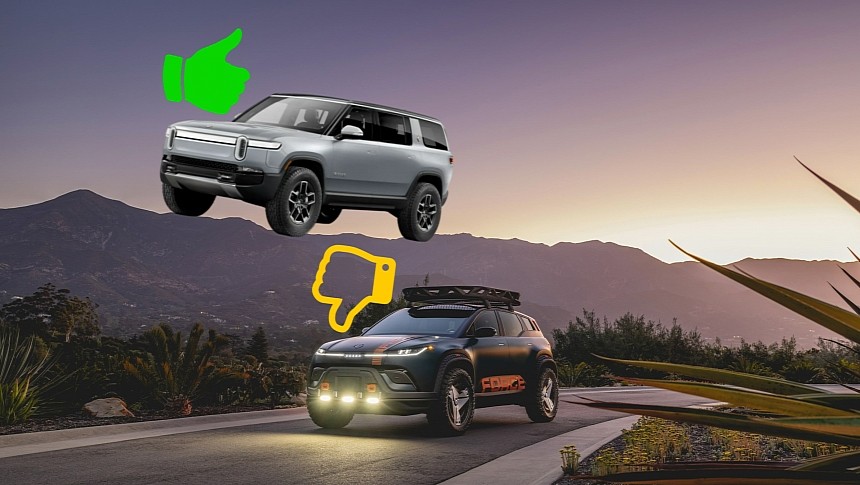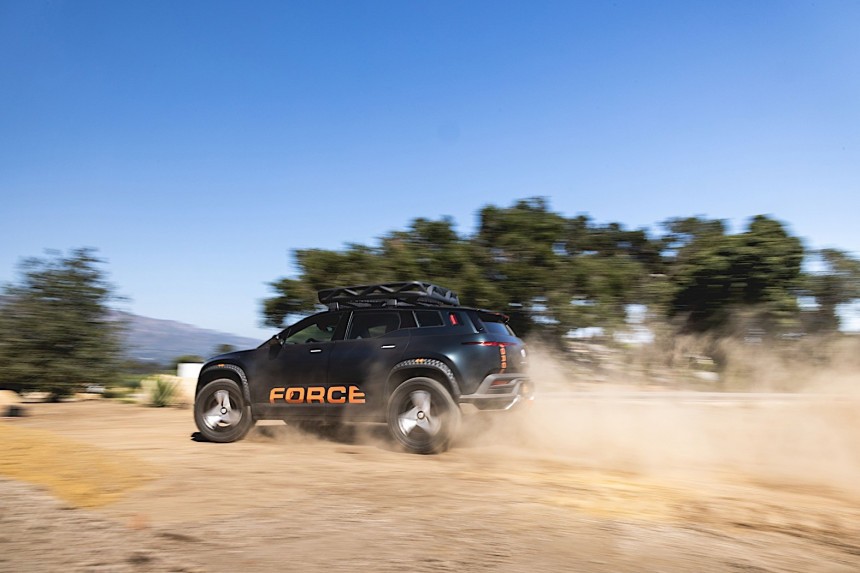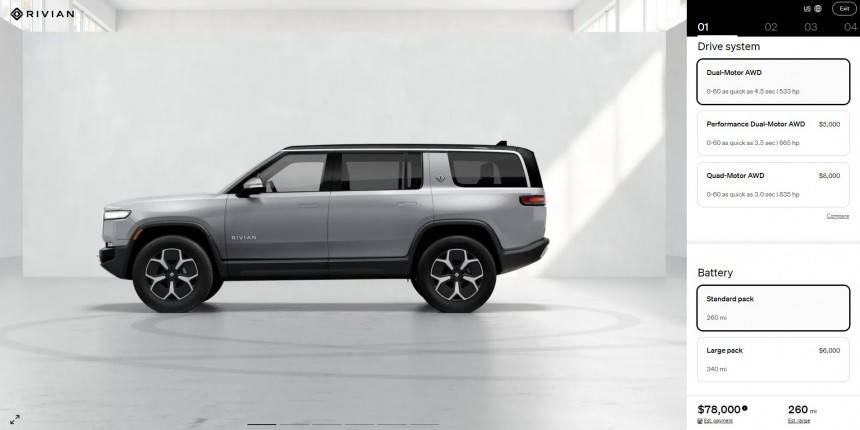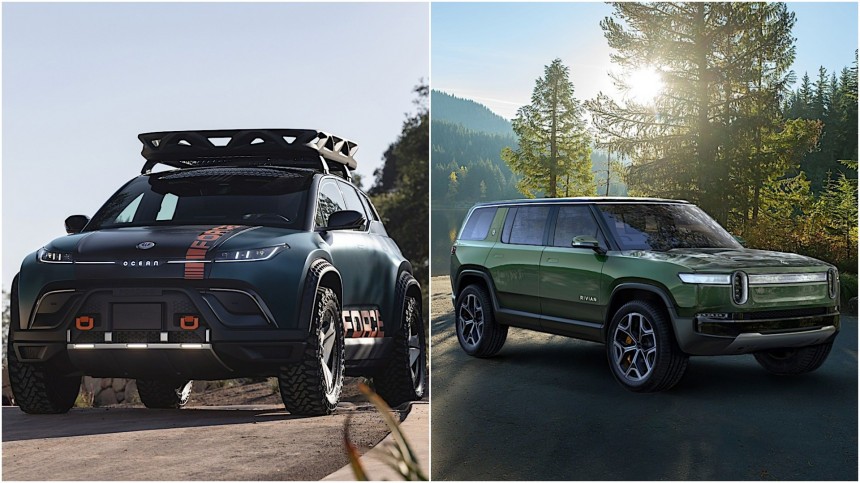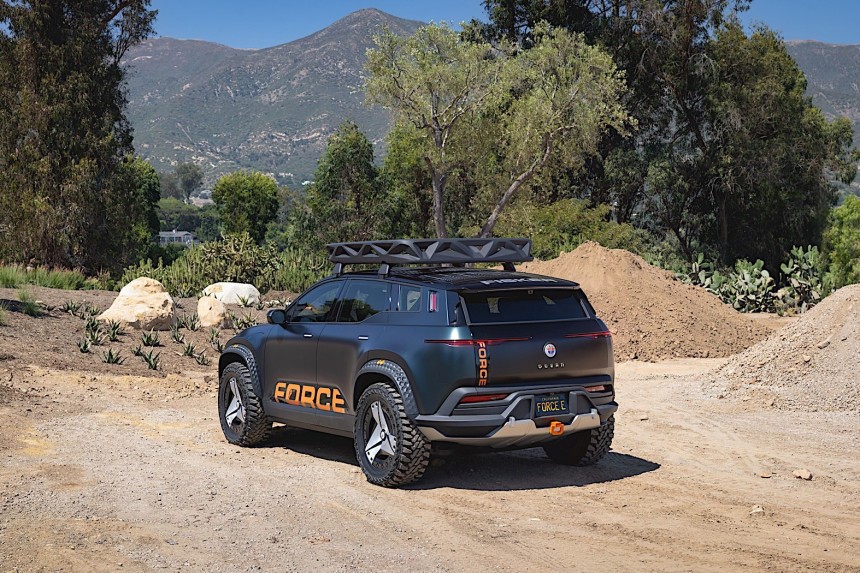Fisker is on a roll. The reborn auto brand accelerated US deliveries, opened a flagship location in Los Angeles for existing and prospective customers, started responding quickly to customer complaints, updated its EV portfolio, and is putting more and more people behind the steering wheel of an Ocean. It has also confirmed the price of the Fisker Ocean with the Force E package that turns the crossover SUV into an off-roader. But is it worth it? Let's dive in.
The Fisker Ocean Extreme includes nearly everything the automaker can offer, even the 360-mile Hyper Range 113-kWh Battery. It has a starting cost of $68,999 with the solar roof included. Don't worry – it can quickly get a lot more expensive. We configured our own, and it ended up costing $85,393 before any taxes and fees.
But let's say you want yours to be just a tad bit more special and capable of handling various types of terrain when the pavement ends.
Putting your name down for the seemingly comprehensive Force E upgrade costs just $250 at the time of writing. But that's just to secure a place in line. The full price is estimated at around $14,000. The automaker can't guarantee that this will be the figure you'll see on the receipt. As such, we expect it to cost slightly more when it finally reaches customers because inflation and supply chain woes are, sadly, still part of the vehicle production process.
Spending $14,000 gets customers 33-inch tires wrapped around 20-inch wheels, "special" dampers (whatever that means), skid plates, more underbody protection, and an off-road mode that's not yet ready for deployment. The setting will be made available to customers later via an over-the-air update.
Moreover, the brand says the add-on is still in development. On top of that, if you buy it separately and retrofit it, additional costs are to be expected.
The Force E Pack is only available for the limited-edition One and the Extreme trims. Fisker says it could also become available for the Ultra sometime in the future. But given the decision to hide some essential functionalities behind a monthly paywall, it's unlikely that customers will choose the lower-priced versions until a change comes.
That's $5,001 more than the MSRP of a Rivian R1S! The Normal-made three-row all-electric SUV has a starting cost of $78,000 when configured as a dual-motor unit with the 260-mile standard pack battery.
But this puts it at a significant disadvantage. The Ocean Extreme has an EPA-rated range of 360 miles – 100 miles more than the cheapest Rivian SUV. Moreover, the Irvine-based brand isn't ready to give customers the smallest battery. The smallest energy storage unit Rivian prepared for its vehicles is expected to become a part of the delivery process in July 2024.
However, customers can choose the 340-mile large pack battery currently in production. Doing so incurs a cost of $6,000, which brings R1S' MSRP to $84,000. For just $1,001 more, you get a mid-size all-electric SUV that can seat seven people. It may have 20 miles of range less, but the Rivian boasts a McLaren 720S-inspired suspension setup, a generous frunk, and ventilated seats.
Moreover, its dual-motor setup developed in-house has an output of 533 hp, which can go up to 665 hp for those willing to come up with an extra $5,000. The Fisker Ocean can only temporarily reach 564 hp when the Boost feature is activated. The rest of the time, the motors put out 468 hp.
Then there's the EV tax credit debacle. The R1S is made in the US, allowing it to qualify for half of the $7,500 incentive Uncle Sam offers. But that's available only for the cheapest version, which comes with the smallest battery that's not being delivered yet.
The Ocean is made in Graz, Austria, and it does not currently meet the eligibility criteria for the federal tax perk.
Early buyers were able to secure the federal incentive last year before the Inflation Reduction Act (IRA) entered into effect. Those willing to pay Fisker an extra $5,000 to secure their orders received the buyer's agreement, which, at the time, was enough.
As such, neither vehicle can obtain the updated EV tax credit. So, which one would be worth buying?
Paying $82,999 for a Fisker Ocean would get me a tough-looking two-row crossover SUV that can theoretically go farther than the R1S. But it'll have less space because it's 12.8 inches shorter, 0.8 inches narrower, and 7.4 inches less tall than the Normal-made SUV. Activate the air suspension, and the height of the Rivian can increase by a further 5.8 inches. Similarly, the Ocean's 115-inch wheelbase is 6.1 inches shorter than the R1S'.
However, the dual-motor and large pack R1S configuration may not be best for off-road use. Adding 34-inch all-terrain tires on 20-inch rims, a compact spare tire, and enhanced underbody protection costs $3,600.
Moreover, the quad-motor version is the best setup for accessing rough terrain or rock crawling, which gives the vehicle 10 driving modes and 302 hp more. But that's another $8,000 in costs. Thus, the MSRP grows to $95,600, making it unfeasible in this scenario.
Considering that Fisker's Force E off-road upgrade is a $14,000 package that promises to introduce a few neat additions in "late Q1 2024," it doesn't make sense to get our hopes up today. The R1S exists, is available when writing, and has proven its worth.
It's the obvious choice for someone who intends to do light off-roading occasionally. Neither the dual-motor R1S nor the Ocean Force E is suited to go on trails where we commonly see people with lifted Jeep Cherokees or modified Toyota pickup trucks.
I might have considered the Ocean Extreme without the Force E package if I had been interested in a stylish all-electric commuting appliance with a slightly more generous ride height and some cool features.
But even then, a Tesla Model Y Long Range might make more sense given its tried and tested drivetrain and software. It also costs $50,490 and is eligible for the entire EV tax credit. Add the reliable Supercharger network into the mix, and it makes choosing the Ocean that much harder.
But let's say you want yours to be just a tad bit more special and capable of handling various types of terrain when the pavement ends.
Putting your name down for the seemingly comprehensive Force E upgrade costs just $250 at the time of writing. But that's just to secure a place in line. The full price is estimated at around $14,000. The automaker can't guarantee that this will be the figure you'll see on the receipt. As such, we expect it to cost slightly more when it finally reaches customers because inflation and supply chain woes are, sadly, still part of the vehicle production process.
Spending $14,000 gets customers 33-inch tires wrapped around 20-inch wheels, "special" dampers (whatever that means), skid plates, more underbody protection, and an off-road mode that's not yet ready for deployment. The setting will be made available to customers later via an over-the-air update.
The Force E Pack is only available for the limited-edition One and the Extreme trims. Fisker says it could also become available for the Ultra sometime in the future. But given the decision to hide some essential functionalities behind a monthly paywall, it's unlikely that customers will choose the lower-priced versions until a change comes.
Meeting the competition
But let's presume you're buying a two-row Ocean Extreme without any extras apart from the Force E pack. That means the EV will have a pre-tax price of 68,999. Add the Force E pack, and the figure grows to $82,999.That's $5,001 more than the MSRP of a Rivian R1S! The Normal-made three-row all-electric SUV has a starting cost of $78,000 when configured as a dual-motor unit with the 260-mile standard pack battery.
But this puts it at a significant disadvantage. The Ocean Extreme has an EPA-rated range of 360 miles – 100 miles more than the cheapest Rivian SUV. Moreover, the Irvine-based brand isn't ready to give customers the smallest battery. The smallest energy storage unit Rivian prepared for its vehicles is expected to become a part of the delivery process in July 2024.
Moreover, its dual-motor setup developed in-house has an output of 533 hp, which can go up to 665 hp for those willing to come up with an extra $5,000. The Fisker Ocean can only temporarily reach 564 hp when the Boost feature is activated. The rest of the time, the motors put out 468 hp.
Then there's the EV tax credit debacle. The R1S is made in the US, allowing it to qualify for half of the $7,500 incentive Uncle Sam offers. But that's available only for the cheapest version, which comes with the smallest battery that's not being delivered yet.
The Ocean is made in Graz, Austria, and it does not currently meet the eligibility criteria for the federal tax perk.
Early buyers were able to secure the federal incentive last year before the Inflation Reduction Act (IRA) entered into effect. Those willing to pay Fisker an extra $5,000 to secure their orders received the buyer's agreement, which, at the time, was enough.
Deciding between the Rivian R1S and the Fisker Ocean Force E is easy
Ordering a dual-motor Rivian R1S with the large pack battery that rides on 21-inch wheels comprising 33-inch all-season Pirelli tires today means I could take delivery until the end of the year. I would end up owning a practical and all-electric three-row SUV that costs $84,000.Paying $82,999 for a Fisker Ocean would get me a tough-looking two-row crossover SUV that can theoretically go farther than the R1S. But it'll have less space because it's 12.8 inches shorter, 0.8 inches narrower, and 7.4 inches less tall than the Normal-made SUV. Activate the air suspension, and the height of the Rivian can increase by a further 5.8 inches. Similarly, the Ocean's 115-inch wheelbase is 6.1 inches shorter than the R1S'.
However, the dual-motor and large pack R1S configuration may not be best for off-road use. Adding 34-inch all-terrain tires on 20-inch rims, a compact spare tire, and enhanced underbody protection costs $3,600.
Moreover, the quad-motor version is the best setup for accessing rough terrain or rock crawling, which gives the vehicle 10 driving modes and 302 hp more. But that's another $8,000 in costs. Thus, the MSRP grows to $95,600, making it unfeasible in this scenario.
It's the obvious choice for someone who intends to do light off-roading occasionally. Neither the dual-motor R1S nor the Ocean Force E is suited to go on trails where we commonly see people with lifted Jeep Cherokees or modified Toyota pickup trucks.
I might have considered the Ocean Extreme without the Force E package if I had been interested in a stylish all-electric commuting appliance with a slightly more generous ride height and some cool features.
But even then, a Tesla Model Y Long Range might make more sense given its tried and tested drivetrain and software. It also costs $50,490 and is eligible for the entire EV tax credit. Add the reliable Supercharger network into the mix, and it makes choosing the Ocean that much harder.
